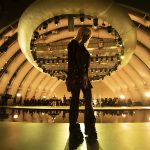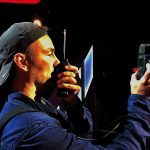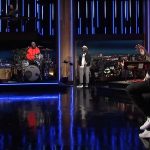Fred Bock has been lighting The Tonight Show Starring Jimmy Fallon since Fallon debuted as the new host of the iconic show on Feb. 17, 2014. After decades on the West Coast, having left NYC for “beautiful downtown Burbank” in 1972, The Tonight Show returned to its roots, moving back to the East Coast. Bock was no stranger to the fast pace and ever-changing setups lighting for late night TV. Over the years, he has lit a number of NBC productions and projects, including 16 years on Late Night with Conan O’Brien.
PLSN: Walk us through the layout of the studio in terms of different setup scenarios you have to address.
Fred Bock:The Tonight Show is shot in Studio 6B at 30 Rockefeller Plaza, the same studio that Jack Paar and Johnny Carson helmed The Tonight Show from for many years. The studio is remarkably small, with 18 feet to the lighting grid, and includes audience seating for 240. The director’s camera work, paired with my lighting and Eugene Lee’s elegant, warm wood scenic design, make Studio 6B appear rather large, but in fact, it isn’t, really. The areas that I have to light include “homebase” with Fallon’s desk and interview seating, then there’s a production area where they do sketches and cooking segments. Upstage of the production area is the performance area for musical acts to perform; when there are larger bands that will spill into the production area. Across from the homebase desk is the area for The Roots, the show’s house band. The audience area also gets lit as well for different bits, so the whole studio needs to be lit depending on the show’s requirements for that night.

Of course, being in NYC, The Tonight Show does like to take segments and musical acts outside the studio as well. NBC even added a new marquee for The Tonight Show on Sixth Avenue that can support production. To inaugurate it, they had Pharrell [Williams] perform up on the marquee. They have also raced go-karts and giant hamster balls in the 30 Rock Plaza and, memorably, the show had U2 perform on Top of the Rock. We are lucky, because there are a lot of areas in and around 30 Rockefeller Plaza for performances.

How does your lighting support the style and the overall look of the show?
As I mentioned, the studio is very small, so I help give the space a sense of size. Our director uses a lot of high angle camera shots and the space would start looking a lot smaller if lights were hung low, so I’ve taken more of a theatrical approach, using ellipsoidals and going right to the grid, backing everything off. By doing this we get the same angle, but the sense of a larger space. Every choice I made and every choice that was made about the show was all about keeping everything up as high as we could to help make the space look as large as it looks on television.
Also, to support and light the scenery, we’ve done as much lighting internally or right up against the wall as possible. I am using more architectural-type fixtures, like [Philips] Color Kinetics’ ColorGraze units to help wash as much of the scenic walls as we could; as bright as possible. By handling the set lighting in an architectural manner, the space itself feels like it’s been there for a long time. This is a very purpose-built studio; but we want it to have that sense of timelessness; history and permanence as well.

What are some of the primary challenges and solutions you’ve found that work for lighting this show?
Well, one of them was trying to get that big look, and then going with all of the lights mounted up tight to the grid and backing everything off. That was probably pretty much the biggest one, but also to accommodate all the different types of areas that I knew we were going to need to have lit in the small studio space.
In some ways, the show is never done. On a daily basis, the challenge really is that it is so fluid. You are making a lot of guesses and assumptions on where lights need to go, to accommodate how it’s going to be shot, to accommodate the types of production you think are going to happen. You start with designing the show from where you know your fixed areas are. Homebase is pretty much a lock; The Roots are going to be pretty much a lock; and the audience will be a lock. Then you work around all those locked areas to put in all the different production lights that we need. Plus, dealing with music, you’re hoping you’re going to have enough coverage to keep most bands happy. We still bring in rental packages for some of the bands; although sometimes we do the adds ourselves. It’s a combination of the two.
What color temperature do you typically shoot?
Right now, we’re roughly at around 3,200K for a color temperature. I’m using all tunable LED fixtures. I looked at going a little cooler, which would certainly help me with the discharge sources that we’re using for music, to get a little more range out of them, but the problem became, for the studio audience, which is an integral part of the show, the cooler the color temperature went, the whole room just felt a lot colder, especially with all of the wood and all the warm tones everywhere. I really felt then that we were better off going closer to 3,200K. Plus, I think Jimmy connects better to an incandescent feel. That determined where the color temperature ended up.
What are some of your key equipment choices?
We made the decision to go all-LED when we started two and a half years ago. For most of my talent lighting, I ended up going with Prism Projection’s RevEAL Profile Juniors and their Studio Fresnels. With the long throws from putting the lights right to the grid, I’m using Fresnels more like soft lights. I also use a lot of the ETC [Source Four LED] Series 2 Lustr ellipsoidals and the ETC Desire D60s.
I feel really strongly that having control over plus and minus green is very important. It is a help that I can dial in a little extra compensation for different flesh tones to get them to feel right. If someone is looking a little too pink, I’ll back off the minus green and maybe go a little bit with the plus green, versus someone that’s looking a little grey and ashen, we’ll add a little more pink to their lights; a little more minus green.
One of the other things that we’re doing is trying to make sure that the dimmer curve is good; that the light doesn’t have a sharp cutoff at the bottom. Because this is different than a news project — light transitions are very important. You want that to dim just like an incandescent. Those were things I carefully looked at as well.
We’ve got a couple of incandescent soft lights, and we’ve got a couple of incandescent birdies here and there as well. There’s also the little ETC Source Four Minis. In addition to the arc source movers, there’s a handful of LED movers as well; some [Martin Professional] MAC Auras, Clay Paky B-Eyes, and GLP impression X4s. For homebase, I have troughs in the riser for the guest area with [Philips Color Kinetics] iWhites for a low fill. Today, if I was selecting gear, I may choose the Matchsticks by Cineo Lighting for this purpose.
Again, because a lot of LED fixtures aren’t that small, to get back lights at homebase became a bit of a challenge. That required a lot of [City Theatrical] Beam Benders, so I could take a fixture and hang it and get the mirror where the lens of the light would need to be. I had to do some tricks that way to get the light where I needed it in a way that I could fit it. If that meant hanging the light, facing it upstage into a mirror, that’s what I did.
I had some issues trying to get backlight into the area for The Roots, since the camera tracks were a last-minute add. I had just enough space behind the track; everything had to be up high, nothing could hang into the track itself, because obviously the camera would knock the lights out of focus all the time or just be an obstruction. That meant tucking lights just to the other side of the track, which had enough room for it and using Beam Benders on those lights as well; just really sneaking that light through past the camera tracks. There’s a lot of crazy math going on.
In regards to the audience lighting, since I had to keep the lights up tight to the grid and had to be back farther, I went with ellipsoidals. I couldn’t drop soft lights in or do anything that was a little more forgiving. With ellipsoidals, I could get them under all the various things that are hanging in the way like monitors and speakers. If we’re doing any high shots from the back, we really don’t want to see a lot of lights hanging low in the shot.
You were an early adopter of LEDs for TV lighting; how do you feel the current crop of LED lighting fixtures work for TV?
I think they’re fine. Everything’s got a look; everything has got a reason. Everything is a tool. There are certain aspects about incandescents that I miss in the studio, but the fact that I can keep a specific color temperature no matter where the intensity of the light is, is incredibly helpful, which you can’t do with incandescent. The other thing that I find incredibly helpful, as I mentioned previously, is that I can fine-tune for flesh tones more so than I could with incandescents. That said, there are certain times where nothing gives you the feel of an incandescent.
From the maintenance end with the LEDs, we’ve had very little problems, very little heat, which also adds to the comfort of the audience. We’re not blasting in a lot of extra AC. When we went LED with the rig, the room ended up 15 degrees colder at the same AC setting. It really isn’t regulated by thermostats, it’s all regulated by a giant blower someplace. So that means we’re using now a lot less cooling. That also helps with the audience comfort and for Jimmy’s comfort.
How do you approach lighting for the musical acts?
It starts with listening to the song, and it starts with collaboration with the artist or the artist’s production team. Sometimes the band has some ideas that I will incorporate, hopefully using our house package. I have a lot of lights for the floor as well as what’s in the air. We try to reach a very high level of production for music, to give each performance its own little unique spin and take, which can be challenging to do on a daily show where we have music four or five nights a week.
I do research and see what they’ve done on other shows or what their concert looks are like for the act. YouTube has become very important to doing research. I try to think about the look from the artist’s standpoint, but also to make sure that we still identify that performance as being on The Tonight Show.
This is something we take seriously; music is very important to Jimmy. There is a historic weight to what we do, because of The Tonight Show brand. Because, sometimes you’re doing performances that are very special, perhaps that person or group hasn’t been on television for a long time. Recently we had The Who on the show. That was their first television appearance as the band The Who, since they played the Smothers Brothers show in the ‘60s. That is 50 years between television appearances. There’s a certain weight to being part of that, and you want to pay respect to that artist’s performance. You want to make sure that that show feels special. All of those things weigh into how we go about dealing with music on the show.
Any other thoughts on lighting The Tonight Show Starring Jimmy Fallon?
I don’t think anyone can truly appreciate the challenges we have on our show without actually seeing the space, because if I can stress anything, it’s a small, small studio. Luckily, we look a lot bigger than we are as far as the size of the studio. Which isn’t to say necessarily that is a bad thing. A bigger studio would be more convenient, but I don’t know if it really would help the show, because there’s a certain intimacy that we have in our tiny little stage that I think works better for all the performers. Of course, when you’re doing The Tonight Show, you want it to feel bigger and larger to the TV audience, which I believe we have all been able to achieve. I think our show, and our approach, is much more of a daily variety show than just a talk show. Certainly Jimmy has done a great job of continuing that aspect of the show’s brand and also making the show his own. It is great to be able to support that work and to do so in this historic NYC studio. \
The Tonight Show Starring Jimmy Fallon airs weeknights at 11:35pm, 10:35c on NBC.


